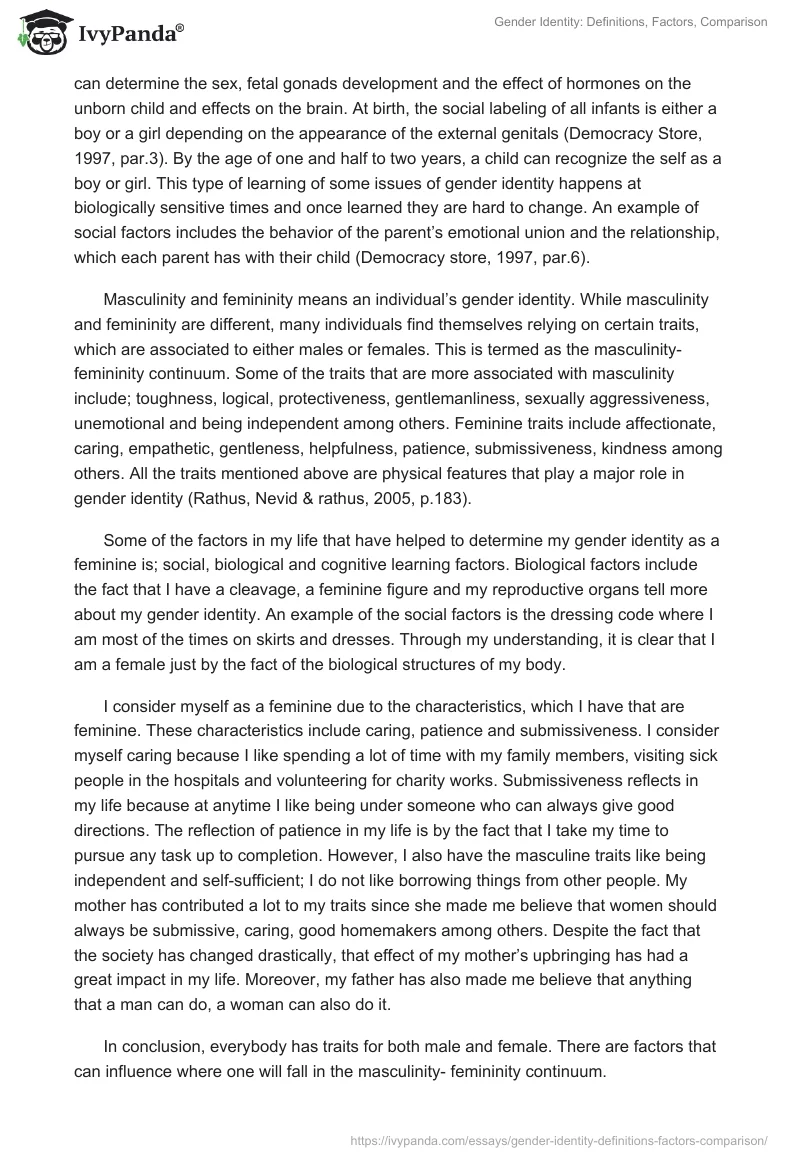Identity in life is a central thing that starts from childhood up to the culmination of an individual’s life. Gender identity refers to individual’s awareness or logic of being a man or a woman and one of the most essential and obvious characteristics of the individual’s self-concepts. Its function in the adolescent growth and development has been essential as the youth get to understand and identify themselves in ways, which were not applicable during their young age of childhood. More particularly, the capability to reflect on someone’s thoughts and therefore, on one’s self, increases a new view of self-discovery, especially of someone’s sexual identity (Huffaker & Calvert, 2005, par. 2).
This paper focuses on the factors of gender identification and gender roles. Gender identity that refers to an individual conception of oneself as female or male has a linkage to the idea of gender role. Gender role refers to the outward expression of personality, which mirrors the gender identity. Gender identity is self-identification that results from the combination of intrinsic/inherent and environmental or extrinsic factors. On the other hand, gender role, is expressed within the community through visible factors like appearance and behavior. For example, if an individual believes she is a female and she is okay with her personal gender, then she can be termed to be a female to bring out the aspect of gender identity. However, her gender role is female if she only displays specific female characteristics in dress code, behavior and morals. In summary, gender identity is the outward manifestation of the gender role (Ghosh, 1994, par.2).
The development of gender identity is through a process of separation or differentiation that include several factors like; social, cognitive learning and interactions of biological factors, which happen from time to time. Differentiation refers to mostly structures that are the same, developing in different ways as they rely on the influence of additional factors. Examples of biological factors include prenatal hormonal setting and genetic complement. The physical features of the male and female fetus are similar for the first one month but after the sixth week of prenatal growth, there are some differences. As the development continues, several influences bring the distinct between the two sexes. The process starts in prenatal stage with the chromosomes that can determine the sex, fetal gonads development and the effect of hormones on the unborn child and effects on the brain. At birth, the social labeling of all infants is either a boy or a girl depending on the appearance of the external genitals (Democracy Store, 1997, par.3). By the age of one and half to two years, a child can recognize the self as a boy or girl. This type of learning of some issues of gender identity happens at biologically sensitive times and once learned they are hard to change. An example of social factors includes the behavior of the parent’s emotional union and the relationship, which each parent has with their child (Democracy store, 1997, par.6).
Masculinity and femininity means an individual’s gender identity. While masculinity and femininity are different, many individuals find themselves relying on certain traits, which are associated to either males or females. This is termed as the masculinity-femininity continuum. Some of the traits that are more associated with masculinity include; toughness, logical, protectiveness, gentlemanliness, sexually aggressiveness, unemotional and being independent among others. Feminine traits include affectionate, caring, empathetic, gentleness, helpfulness, patience, submissiveness, kindness among others. All the traits mentioned above are physical features that play a major role in gender identity (Rathus, Nevid & rathus, 2005, p.183).
Some of the factors in my life that have helped to determine my gender identity as a feminine is; social, biological and cognitive learning factors. Biological factors include the fact that I have a cleavage, a feminine figure and my reproductive organs tell more about my gender identity. An example of the social factors is the dressing code where I am most of the times on skirts and dresses. Through my understanding, it is clear that I am a female just by the fact of the biological structures of my body.
I consider myself as a feminine due to the characteristics, which I have that are feminine. These characteristics include caring, patience and submissiveness. I consider myself caring because I like spending a lot of time with my family members, visiting sick people in the hospitals and volunteering for charity works. Submissiveness reflects in my life because at anytime I like being under someone who can always give good directions. The reflection of patience in my life is by the fact that I take my time to pursue any task up to completion. However, I also have the masculine traits like being independent and self-sufficient; I do not like borrowing things from other people. My mother has contributed a lot to my traits since she made me believe that women should always be submissive, caring, good homemakers among others. Despite the fact that the society has changed drastically, that effect of my mother’s upbringing has had a great impact in my life. Moreover, my father has also made me believe that anything that a man can do, a woman can also do it.
In conclusion, everybody has traits for both male and female. There are factors that can influence where one will fall in the masculinity- femininity continuum.
Reference
Discovery Score, (1997). Illustration of the sequential and interactional components of gender-identity differentiation. Money, Principles of Developmental Psychology. New York: Continuum. 2009. Web.
Ghosh, S. (1994). Sexuality, Gender Identity. E-medicine. 2009. Web.
Huffaker, D., & Calvert, S. (2005). Gender, identity, and language use in teenage blogs. Journal of Computer-Mediated Communication, 10(2). 2009. Web.
Rathus, A., Nevid, S., & Rathus, F. (2005) Human Sexuality in a World of Diversity. Sixth Ed. Allyn and Bacon.


